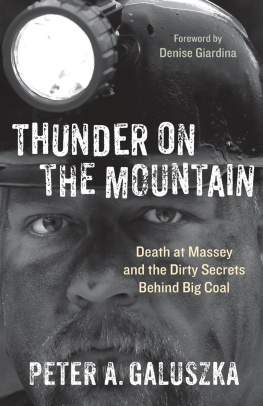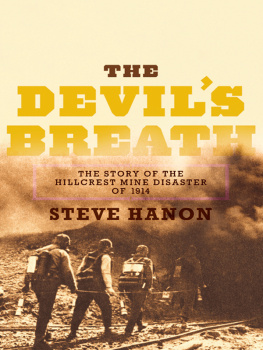
The author and publisher have provided this e-book to you for your personal use only. You may not make this e-book publicly available in any way. Copyright infringement is against the law. If you believe the copy of this e-book you are reading infringes on the authors copyright, please notify the publisher at: us.macmillanusa.com/piracy.
For Marina and our children, Camille and Maria
CONTENTS
PREFACE
Appalachian coal has been a part of my life for years, however tangentially. My introduction occurred in 1962, when I was nine years old. My father, an altruistic navy doctor in Bethesda, Maryland, decided to retire from his military career and took us to central West Virginia, a place where we had no family or other ties. He had other opportunities to practice medicine in more sophisticated and better-paying locales, but he wanted to work where he could do the most good. My sister and I were shipped from one of the most affluent counties in the country to one of the poorest. My fifth-grade arithmetic book had been in use since 1903. I rode school buses with coal miners children over endlessly twisting mountain roads. We had been modestly comfortable on Dads navy pay in the D.C. area. In Harrison County, West Virginia, where the War on Poverty was declared by Lyndon B. Johnson in 1964, we were considered rich.
I used to play on strip mines near my home, skirting the skeletons of small animals next to rain ponds made toxic by exposed coal because of lax regulation. On occasion, a schoolmates dad would die when a heavy piece of a coal mines roof, usually a slab of slate, would fall. We usually would learn of a death only after a child didnt show up on our school bus.
Years later, my journalism career took me back to the area. One visit was in 1979, when energy prices spiked so high that one hundred coal ships swung at anchor, waiting for coal dock space at Hampton Roads, Virginia, where I worked for a newspaper. My first job with McGraw-Hill in 1983 was working for a Washington-based coal-industry newsletter that had me hopscotch the United States visiting coal mines, including ones in Central Appalachia. In 2002, I interviewed Don Blankenship, a subject of this book, who graciously let me visit a Massey Energy deep mine that was low coal, meaning its seams were about forty-nine inches tall, forcing miners to work in a stooped-over position for hours.
I have come to know coals dangers firsthand and the culture it comes from. I care about the people who make their living from it and the human lives, mountains, and streams it destroys. I wanted to write this book to help me understand what it was about the Appalachians that so intrigued me. The contradictions are enormous: so much potential wealth but, in reality, so much poverty; beautiful, rugged landscapes marred by miles of tan strip-mine gashes; and people and ideas isolated by geography and culture. I want to explain it to others.
INTRODUCTION
For Appalachia, coal is a curse and a prize. Since the nineteenth century, it has built cities, electrified houses, and been used for transportation and synthetic energy. It has also killed thousands of miners, ruined many lungs, polluted many streams, and bitten off huge chunks of some of the most beautiful mountains in the United States. Although coals uses have shifted over the yearsrailroads no longer run on it nor are homes heated with itmore coal is produced than ever before, providing nearly half of all electricity generated in twenty-first-century America and building skyscrapers and highways in Shanghai and Mumbai.
Coals contradictions come together most tellingly in the form of one man, Donald Blankenship, a child of the Central Appalachians who was chairman and chief executive officer of Americas fourth-largest coal firm, Massey Energy. Like the rawboned settlers in the hills of southern West Virginia and Eastern Kentucky, Blankenship was tough, independent minded, and not at all beholden to whatever latest management fad was coming out of business schools. Even now, Blankenship makes no bones about breaking unions, telling environmentalists where to get off, bankrolling mountain politicians and judges, and resisting complaints of do-good green investors who were critical of Masseys poor safety record and devastating mountaintop-removal practices.
Although Blankenship was forced to retire and his company was taken over by a competitor after a massive explosion killed twenty-nine miners at Masseys Upper Big Branch Mine in 2010, the tensions of the industry remain. Coal remains exceptionally well positioned to continue as a major source of electrical power, given the Fukushima nuclear power plant disaster in Japan and the dearth of carbon-control legislation. Another dynamic is also driving coalthe insatiable demand by the fast-growing Asian countries such as China and India, which need great amounts of metallurgical (or met) coal to make coke and steel.
For the coal industry, its list of dirty secrets prevails. The industry doesnt want people to know how it is destroying mountains and fragile ecosystems with its mountaintop-removal practices. Its propaganda says that it is taking necessary safety and environmental risks to keep Americas electric lights on, when, in fact, much of the coal mined in the region, and notably at Upper Big Branch, has absolutely nothing to do with electricity generation. It is bound for the international market to make steel in foreign countries. Despite the abuses that led to the twenty-nine dead at Upper Big Branch, the coal industry and its well-financed lobbyists have effectively killed any meaningful legal and regulatory reforms that would take such needed measures as having boards of directors and top corporate officials of coal firms held criminally liable if they know of unsafe mining conditions and take no steps to correct them. As the usual way of doing business prevails, the cycle of injustice endures. The worlds best metallurgical coal comes from Central Appalachia, ensuring big profits for coal operators, yet the region remains among the poorest in the country, as it always has been.
DEATH AT UPPER BIG BRANCH
In the morning darkness of April 5, 2010, Tommy Davis left his home with its cluttered yard for work. A sinewy, forty-three-year-old who rides Harleys and hunts black bears with a bow and arrow, Davis had worked at a Massey Energy Company surface mine for twelve years. Four months before, drawn by higher pay and the chance to work with as many as five of his relatives, including Cory, his son, he had transferred to Masseys Upper Big Branch deep mine about forty-five minutes away in Raleigh County in the Coal River Valley.
The day before had been Easter Sunday. Work at Upper Big Branch had been suspended so miners could enjoy their usual paschal activities. Families attended church, searched for Easter eggs with their children, and ate baked ham dinners. An early shift had started at midnight but did little more than maintenance work. The first regular production run began at 6 A.M . Dawn that Monday, April 5, promised temperatures in the 70s, unusually warm for the fickle early spring of southern West Virginia. There, snow showers and wind quickly change back and forth into sunny days that bring out ramps, a wild-growing onion with a pungent garlic aroma that is a seasonal delicacy in this part of Appalachia, and the chirping of spring peeper frogs.
Known as UBB, the fifteen-year-old mine is nestled on the west side of a narrow valley marked by Coal River, which after spring rains is a brown, wildly churning stream capped by small wavelets of white water. Potato chip bags, bits of clothing, and other trash cling to tree limbs after floods push the river over its banks. Next to it, on a CSX Transportation rail branch line, hopper cars clatter in for loading at the valleys half a dozen or so mining operations. Scattered here and there amid the hardwood trees and rock outcrops are reminders of just how hazardous coal work can be. Occasional roads of industrial-grade gravel leading to coal mines have signs boldly lettered AMBULANCE ENTRANCE .
Next page



